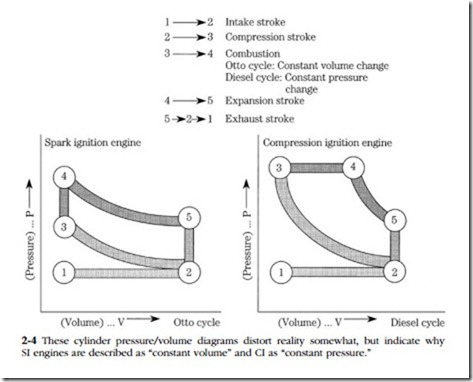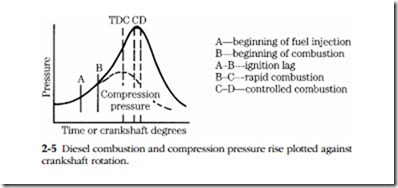Ignition and combustion
SI engines are fired by an electrical spark timed to occur just before the piston reaches the top of the compression stroke. Because the full charge of fuel and air is present, combustion proceeds rapidly in the form of a controlled explosion. The rise in cylinder pressure occurs during the span of a few crankshaft degrees. Thus, the cylinder volume above the piston undergoes little change between ignition and peak pressure. Engineers, exaggerating a bit, describe SI engines as “constant volume” engines (Fig. 2-4).
Compared to SI, the onset of diesel ignition is a leisurely process (Fig. 2-4). Some time is required for the fuel spray to vaporize and more time is required for the spray to reach ignition temperature. Fuel continues to be injected during the delay period.
Once ignited, the accumulated fuel burns rapidly with correspondingly rapid increases in cylinder temperature and pressure. The injector continues to deliver fuel through the period of rapid combustion and into the period of controlled combustion that follows. When injection ceases, combustion enters what is known as the afterburn period.
The delay between the onset of fuel delivery and ignition (A–B in Fig. 2-5) should be as brief as possible to minimize the amount of unburnt fuel accumulated in the cylinder. The greater the ignition lag, the more violent the combustion and resulting noise, vibration, and harshness (NVH).
Ignition lag is always worst upon starting cold, when engine metal acts as a heat sink. Mechanics sometimes describe the clatter, white exhaust smoke, and rough combustion that accompany cold starts as “diesel detonation,” a term that is mis- leading because diesels do not detonate in the manner of SI engines. Combustion should smooth out after the engine warms and ignition lag diminishes. Heating the incoming air makes cold starts easier and less intrusive.
In normal operation, with ignition delay under control, cylinder pressures and temperatures rise more slowly (but to higher levels) than for SI engines. In his pro- posal of 1893, Rudolf Diesel went one step further and visualized constant pressure expansion: fuel input and combustion pressure would remain constant during the
expansion, or power, stroke. He was able to approach that goal in experimental engines, but only if rotational speeds were held low. His colleagues eventually aban- doned the idea and controlled fuel input pragmatically, on the basis of power output. Even so, the pressure rise is relatively smooth and diesel engines are sometimes called “constant pressure” devices to distinguish them from “constant volume” SI engines (shown back at Fig. 2-4).

